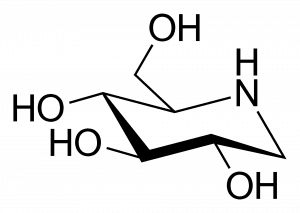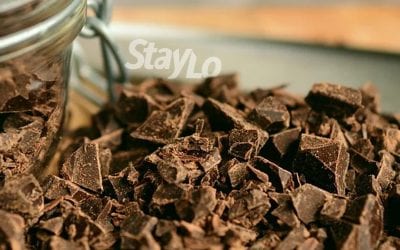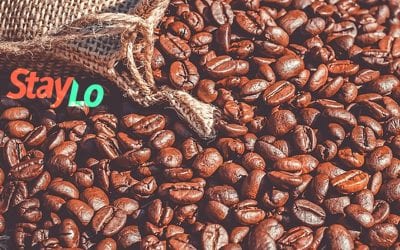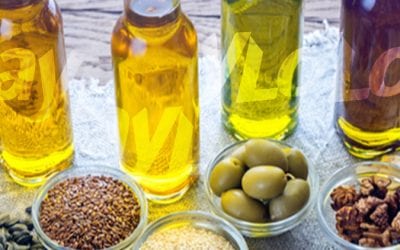WHAT IS 1-DEOXYNOJIRIMYCIN
Also known as DNJ what is the active ingredient of StayLo?
DNJ
What is it in simple language
DNJ is a naturally occurring and potent sugar look alike that blocks one the enzyme your body puts out to break down starch and table sugar. It is most often found in mulberry leaves and silkworms at small doeses. DNJ possesses anti-hyperglycemic, anti-obese, anti-viral and anti-tumor properties.
StayLo uses DNJ as the main active ingredient by using a patented water based extraction process and delivers a dose that is 5% DNJ to block up to 40% or more of the carbs and table sugar that makes up much of the food we eat.
DNJ
What is it in scientific terms
 1-Deoxynojirimycin (DNJ or 1-DNJ), also called duvoglustat or moranolin, is an alpha-glucosidase inhibitor, that works by preventing the digestion of carbohydrates (such as starch and table sugar). Carbohydrates are normally converted into simple sugars (monosaccharides) by alpha-glucosidase enzymes present on cells lining the intestine, enabling monosaccharides to be absorbed through the intestine. Hence, alpha-glucosidase inhibitors reduce the impact of dietary carbohydrates on blood sugar. According to the NIH DNJ is a potent α-glucosidase inhibitor and it possesses anti-hyperglycemic, anti-obese, anti-viral and anti-tumor properties. Some derivatives of 1-DNJ, like miglitol, miglustat and migalastat, were applied clinically to treat diseases such as diabetes and lysosomal storage disorders.
1-Deoxynojirimycin (DNJ or 1-DNJ), also called duvoglustat or moranolin, is an alpha-glucosidase inhibitor, that works by preventing the digestion of carbohydrates (such as starch and table sugar). Carbohydrates are normally converted into simple sugars (monosaccharides) by alpha-glucosidase enzymes present on cells lining the intestine, enabling monosaccharides to be absorbed through the intestine. Hence, alpha-glucosidase inhibitors reduce the impact of dietary carbohydrates on blood sugar. According to the NIH DNJ is a potent α-glucosidase inhibitor and it possesses anti-hyperglycemic, anti-obese, anti-viral and anti-tumor properties. Some derivatives of 1-DNJ, like miglitol, miglustat and migalastat, were applied clinically to treat diseases such as diabetes and lysosomal storage disorders.
DNJ is most commonly found in mulberry leaves. Although it can be obtained in small quantities by brewing an herbal tea from mulberry leaves. StayLo’s extraction process is a patented water extraction that obtains large quantities (5%) of DNJ.
1-Deoxynojirimycin is a polyhydroxylated piperidine alkaloid produced from D-Glucose in various plants, such as Commelina communis, and in the Streptomyces and Bacillus bacteria. High quantities of this azasugar are produced in Bacillus subtilis, a process initiated by a TYB gene cluster composed of gabT1 (aminotransferase), yktc1 (phosphatase), and gutB1 (oxidoreductase).
In Bacillus subtilis, D-glucose first undergoes glycolysis, opening the 6 member ring and producing fructose-6-phosphate. GabT1 catalyzes transamination at the C2 position, followed by a dephosphorylation by the Yktc1 enzyme, resulting in 2-amino-2-deoxy-D-mannitol (ADM), an essential precursor. Regio-selective oxidation by GutB1 occurs at the exposed C6 hydroxyl of ADM, pushing a C2-N-C6 cyclization of the resulting 6-oxo intermediate, creating Manojirimycin (MJ). Epimerization of MJ at the C2 position yields the nojirimycin isomer. Nojirimycin is then dehydrated (loss of -OH at C1 position), along with reduction of the imine moiety. This results in the product 1-DNJ.
DNJ
Scientific studies done by others
- 1-Deoxynojirimycin and its Derivatives: National Institute of Health
- Evaluation of the anti-hyperglycemic effect and safety of microorganism 1-deoxynojirimycin
- 1-Deoxynojirimycin from mulberry leaves changes gut digestion and microbiota composition in geese
- Mulberry 1-deoxynojirimycin (DNJ): an exemplary compound for therapeutics
- Effect of 1-Deoxynojirimycin Isolated from Mulberry Leaves on Glucose Metabolism and Gut Microbiota in a Streptozotocin-Induced Diabetic Mouse Model | Journal of Natural Products (acs.org)
- 1-Deoxynojirimycin, its potential for management of non-communicable metabolic diseases
- 1-Deoxynojirimycin in Mulberry (Morus indica L.) Leaves Ameliorates Stable Angina Pectoris in Patients With Coronary Heart Disease by Improving Antioxidant and Anti-inflammatory Capacities
- An overview of the biological production of 1-deoxynojirimycin: current status and future perspective
KNOWLEDGE ARTICLES
Other articles that might be of interest
This doctor is healthy and wears a constant blood glucose monitor daily, find out why and a whole lot more about blood sugar.
This doctor is healthy and wears a constant blood glucose monitor daily, find out why and a whole lot more about blood sugar.
Glycemic Index Least Wanted List
What are the foods you most want to avoid to keep low blood sugar? We have the top 8 and #7 is a shock!
The glycemic index of pasta
The glycemic index of pasta made from wheat (most pasta) depends on the way it is cooked and what it is cooked with. Pasta cooked "al dente" (somewhat firm) has the lowest glycemic index. The longer you cook it, the softer it is, and the higher the GI.
Does soda make me age faster?
The market is full of products designed to slow down the aging process, but some things you buy, like soda, may actually cause the aging in your cells to speed up. Hopefully this doesn’t burst your bubble, but soda is one of the primary sources of excess sugar in the...
Chocolate and your gut flora
You probably don’t think that chocolate and the bacteria living in your gut would be healthy, but new research has been going a long way towards proving that notion false. Chocolate, especially darker varieties, can play an important role in keeping your body healthy....
Metabolic Syndrome
A cluster of conditions that increase the risk of heart disease, stroke, and diabetes. Metabolic syndrome includes high blood sugar, high blood pressure, excess body fat around the waist, and abnormal cholesterol levels. The syndrome increases the risk of heart...
Can muscular strength prevent the metabolic syndrome?
Muscular strength is an important part of your overall health. That’s overall health, mind you, not just running, jumping and having toned muscles. Maintaining the right amount of muscle in your body is important throughout your life for keeping all the inner workings...
Can coffee prevent diabetes?
We don’t always associate coffee with good health, but new evidence continues to point at various benefits we can have from a few cups each day. Scientists have released a study pointing at the relationship between coffee and type 2 diabetes. While the precise...
Being overweight, memory loss and a shrinking brain
Being overweight will obviously affect your heart and energy levels, but it can also be detrimental to other areas you may not expect. Numerous studies have shown that your body is a network of interconnected systems. Similar to how an ecosystem functions, changes to...
Are there toxic chemicals in my vegetable oil?
Are there toxic chemicals in my vegetable oil? Cooking oil has been connected to plenty of health problems and it’s well known that too much fried food can cause obesity, heart disease and more. However, switching from one type of polyunsaturated vegetable oil to...








